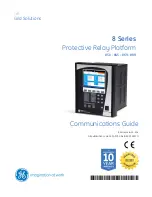
27/Q
The undervoltage-controlled reactive power protection protects the system for mains decoupling purposes. To
prevent a voltage collapse in energy systems, the generating side, e.g. a generator, must be equipped with
voltage and frequency protection devices. An undervoltage-controlled reactive power protection is required at
the supply system connection point. It detects critical power system situations and ensures that the power
generation facility is disconnected from the mains. Furthermore, it ensures that reconnection only takes place
under stable power system conditions. The associated criteria can be parameterized.
Applications
•
High-voltage and extra-high voltage power systems
•
Medium-voltage power systems
•
Regenerative infeed types such as wind power stations, photovoltaics, cogeneration plants or hydro-
power
Functional Description
General
To detect critical power system situations, the QU protection uses the phase-to-phase voltage, the positive-
sequence current and the reactive power.
To release the reconnection, the results of voltage protection and frequency protection are additionally
analyzed on the generating side.
If the frequency and voltage values are outside the operating range, the QU protection does not work.
It can also be blocked by the fuse-failure monitor or via a binary input.
Pickup of the QU protection causes the device to pick up. Simultaneously, fault recording is activated. But trip-
ping of the QU protection does not cause the device to trip and should be routed to a separate binary output.
No other fault record is started.
The QU protection can be used for all voltage connection types that enable detection of the displacement
voltage (measured or calculated). The Appendix provides connection examples.
Signal transmission in the high-voltage power system requires the power system connection point and the
generating facility to be connected via telecommunication cables (optical fiber or copper cable). Radio links,
GPRS or satellite transmission with signal transit times <3 s can alternatively be used in medium-voltage
systems.
Protection Function
The QU protection trips under the following conditions:
•
All 3 phase-to-phase voltages are below the parameterized threshold value.
•
The positive-sequence current
Ι
1
is above the parameterized threshold value.
•
The facility requires more than the set reactive power.
The pickup thresholds for undervoltage
U< Pickup
, the reactive power
Q> Pickup
and the release current
I-Release
can be set.
After detection of the tripping criteria, time-delayed trip signals are sent to the circuit breaker of the power
system connection point and to the circuit breaker of the generating facility. The time delay can be set sepa-
rately for both circuit breakers. Time-graded tripping is thus possible. The tripping of the circuit breaker at the
power system connection point ultimately de-energizes the entire generating facility.
To prevent tripping of the QU protection during starting operations, parameterize and activate the inrush
current detection. The inrush blocking of the QU protection can then be activated via parameter
Inrush
blk
. The overcurrent protection detects the inrush. The QU protection evaluates the inrush indications of the
overcurrent protection (see
).
The following figure shows the logic diagram of the QU protection.
2.10
2.10.1
Functions
2.10 27/Q
SIPROTEC 4, 7SJ62/64, Manual
167
C53000-G1140-C207-8, Edition 08.2016
Summary of Contents for SIPROTEC 4
Page 8: ...8 SIPROTEC 4 7SJ62 64 Manual C53000 G1140 C207 8 Edition 08 2016 ...
Page 18: ...18 SIPROTEC 4 7SJ62 64 Manual C53000 G1140 C207 8 Edition 08 2016 ...
Page 30: ...30 SIPROTEC 4 7SJ62 64 Manual C53000 G1140 C207 8 Edition 08 2016 ...
Page 540: ...540 SIPROTEC 4 7SJ62 64 Manual C53000 G1140 C207 8 Edition 08 2016 ...
Page 594: ...594 SIPROTEC 4 7SJ62 64 Manual C53000 G1140 C207 8 Edition 08 2016 ...
Page 720: ...720 SIPROTEC 4 7SJ62 64 Manual C53000 G1140 C207 8 Edition 08 2016 ...










































